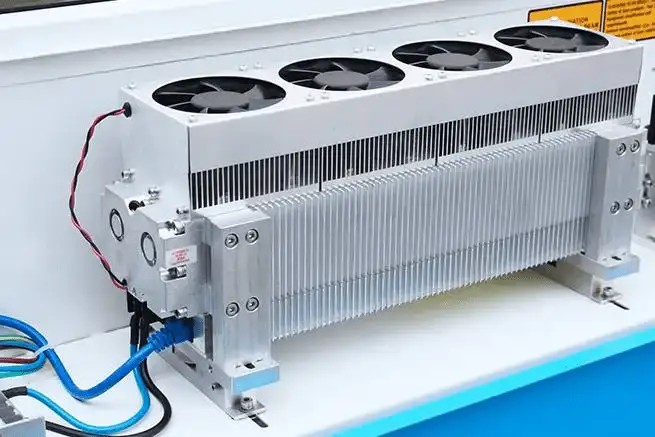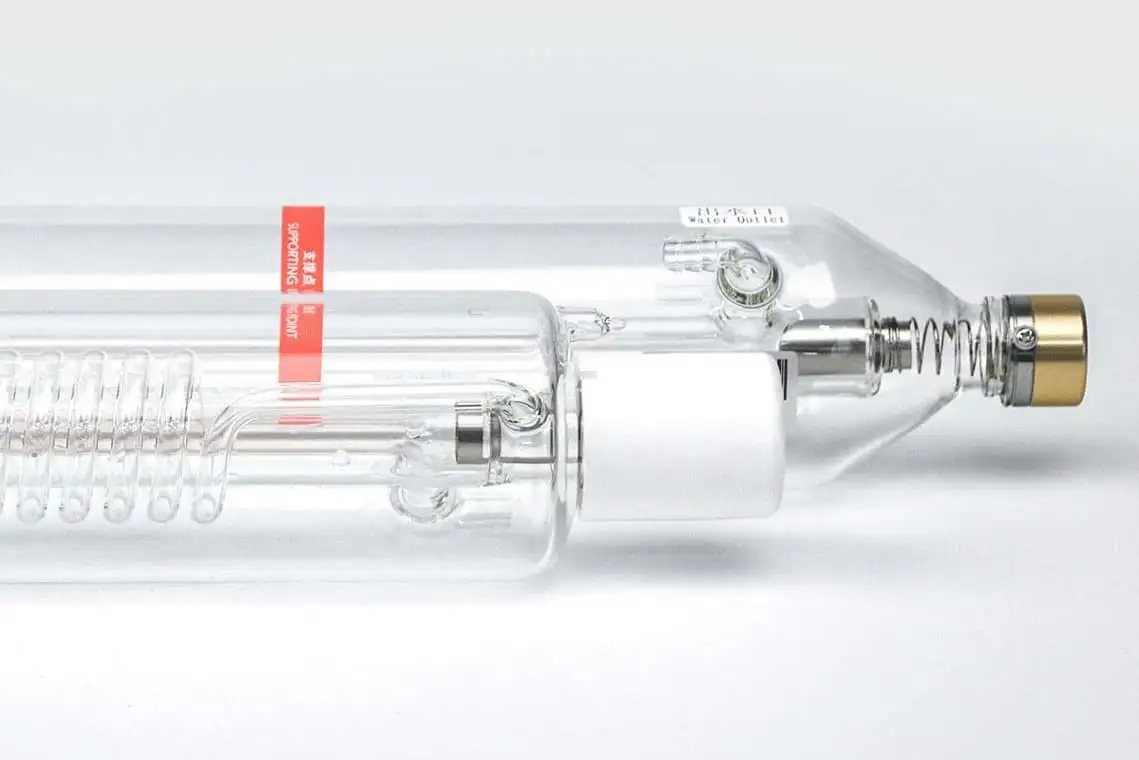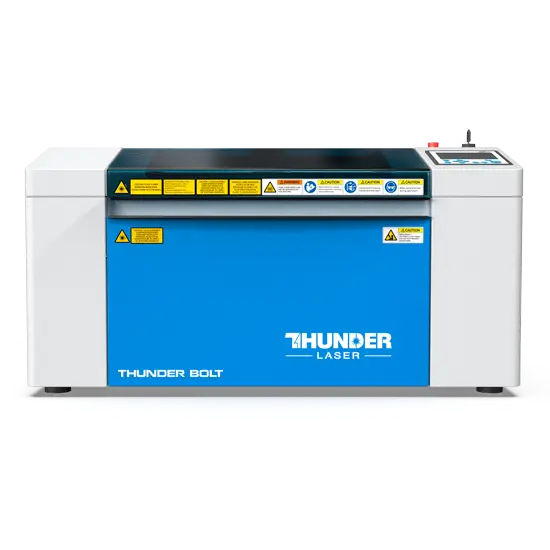Choosing the right CO₂ laser tube can significantly impact your engraving and cutting quality, efficiency, and long-term operating costs. Among the available options, the RF laser tube stands out for its superior beam quality, durability, and safety features. Unlike traditional glass tubes, RF metal tubes require no high voltage or water cooling, making them ideal for professional environments where precision and stability are top priorities.
In this article, we’ll break down the key differences between RF and glass laser tubes and help you determine which one is best suited for your specific needs.
Let’s get started!

The RF metal lasers are designed to operate without high voltage or water cooling. This makes RF metal lasers inherently safer to operate in almost any environment.
RF metal lasers are designed to be durable, provide the highest performance with high laser beam quality, offer indefinite service life, and help assure operator safety.
The price is more expensive than DC glass tube, but they have a longer lifespan of up to approximately 10,000hours.
The only drawback of RF tubes is their higher cost; in all other aspects, they outperform glass tubes. They offer better engraving results, longer lifespan, and more efficient heat dissipation. Of course, glass tubes also have their advantages. How to choose between a metal RF tube and a glass tube? I will explain it to you in 5 minutes.
1. What Makes RF Different from Glass
When comparing an RF laser tube with a traditional glass laser tube, the differences extend well beyond construction materials. These two types of CO2 laser sources diverge in several key areas—including cost, lifespan, and beam quality. Whether you’re aiming for cost-effectiveness or pursuing long-term performance and precision, it’s important to understand how an RF laser tube stands apart. Let’s break down the comparison across three critical aspects.
1.1. Laser tube Price
RF Metal Tube: High cost, ranging from $5,000 to $30,000.
Glass Laser Tube: Affordable, ranging from $400 to $1,500.
1.2. Laser tube Lifespan
CO2 RF tubes are stable and maintenance-free. They can be recharged and used repeatedly with a lifespan of over 10,000 hours. Thunder Laser offers a 2-year warranty.
CO2 glass tubes have a relatively shorter lifespan compared to RF Laser Tubes, generally lasting between 2,000 to 4,000 hours. Thunder Laser provides a 1-year warranty.
Lifespan also depends on your working environment and maintenance; some glass tubes can last over 5 years.
1.3. Laser Beam Quality
CO2 metal RF tubes produce high-quality beam spots with a circular and uniform pattern. Thunder Laser also equips them with beam expanders, resulting in a small divergence angle. After focusing, a smaller laser point can be achieved.
CO2 glass tubes produce beam spots with a less favorable pattern compared to RF tubes, resulting in larger laser points after focusing. Therefore, in terms of engraving, RF Laser Tubes have an advantage, delivering better engraving results.

2. How to Choose Right Laser Tube
2.1. Engraving or Cutting
Both RF tubes and Glass tubes can be used
for laser cutting and engraving, but RF tubes provide better engraving results
and faster engraving speeds. If your work focuses on engraving, consider using
an RF tube. If cutting is your primary task, consider a Glass tube. At the same
power level, Glass Tubes are more cost-effective.
2.2.Industry Applications
Due to its stability and small beam size, RF tubes are commonly used for large-area marking, 3D printing, as well as high-speed cutting, engraving, and welding of flexible and non-metal solid materials. Glass Tubes are often used in industries like leather, clothing, advertising, and non-metal processing.
3. Famous Brands of Laser Tubes Worldwide
There are many brands of CO2 RF tubes, with Coherence, Synrad, Rofin, Radion, CRD, and SPT being some of the well-known ones.
The production of CO2 glass laser tubes is mainly centered in China, which holds a 90% market share. Key glass tube brands include Reci Laser, SPT Laser, EFR Laser, and YL Laser.
Thunder Laser utilizes RF laser tubes from Coherence and SPT, and Glass Laser tubes from Reci Laser and SPT for its machines.
Our Nova series employs Glass Laser tubes, which are ideal for laser cutting applications.
Our Bolt series uses RF metal Laser tubes, offering high speed and precision, primarily for laser engraving.

If you’re curious about the effectiveness of RF Laser tubes, don’t miss our newly released desktop laser engraving machine, Thunder Bolt. It’s the most cost-effective RF laser machine on the market, boasting a super high engraving speed of 1000mm/s, all for just $4995.
If you have any further questions, please consult our laser experts for tailored advice.
Conclusion
While the RF laser tube may come at a higher upfront cost, its benefits in terms of performance, precision, and longevity make it a worthwhile investment for users who prioritize high-quality engraving and long-term value. On the other hand, glass laser tubes offer excellent affordability and are ideal for users focused on cutting tasks or operating on a tighter budget.
Ultimately, the best choice depends on your specific application and production goals. If you’re still unsure which laser tube is right for you, our Thunder Laser experts are here to help you make an informed decision.
FAQs About RF Laser Tube
Q1. Is an RF laser tube better for engraving than a glass tube?
Yes, RF tubes provide superior beam quality and precision, making them ideal for high-speed, high-resolution laser engraving tasks.
Q2. Why is an RF laser tube more expensive than a glass tube?
RF tubes are built with metal housing and use advanced RF technology, resulting in better performance, longer life, and safer operation, which justifies the higher price.
Q3. How do RF tubes handle heat dissipation?
RF tubes dissipate heat more efficiently due to their metal construction and air-cooling design, minimizing the risk of overheating.
Q4. What materials can RF laser tubes engrave or cut?
RF CO₂ lasers can process wood, acrylic, plastic, paper, leather, rubber, glass, and many other non-metallic materials.
Q5. Is an RF laser tube safer than a glass laser tube?
Yes. RF tubes don’t require high-voltage power or water cooling, significantly reducing safety risks during operation.


.png) International
International
 United States
United States
 Brasil
Brasil
 Canada
Canada
 Costa Rica
Costa Rica
 Mexico
Mexico
 Česká
Česká
 Romania
Romania
 Polska
Polska
 Ireland
Ireland
 Portugal
Portugal
 Lietuva
Lietuva
 Россия
Россия Deutschland
Deutschland
 Britain
Britain
 Україна
Україна
 France
France
 Sverige
Sverige
 Italia
Italia
 Norway
Norway
 Denmark
Denmark
 Ελλάδα
Ελλάδα
 한국
한국
 中国
中国
 ประเทศไทย
ประเทศไทย
 中国香港
中国香港
 Israel
Israel
 中國臺灣
中國臺灣
 India
India
 پاکستان
پاکستان
 پශ්රී ලංකා
پශ්රී ලංකා
 ジャパン
ジャパン
 Australia
Australia
 New Zealand
New Zealand
 South Africa
South Africa